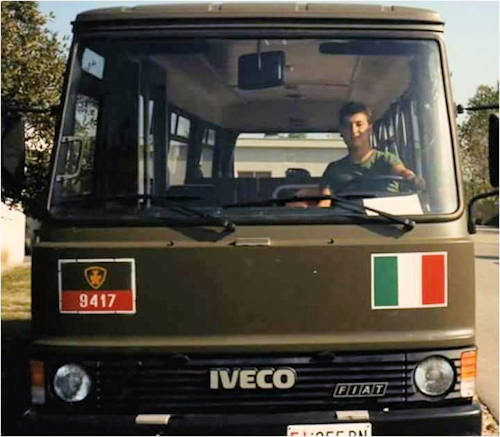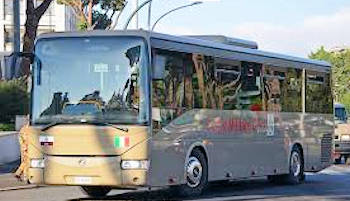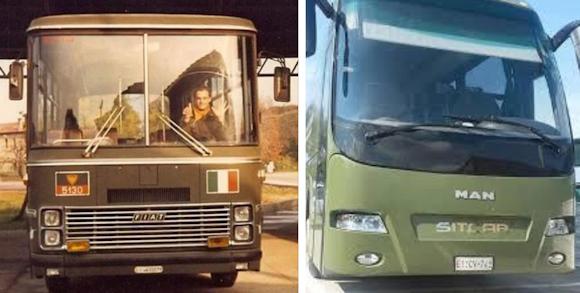This time we will talk about quieter vehicles, not from the front line, that is, those that in common parlance are buses and minibuses, while more correctly the highway code defines them as "motor vehicles" by adding the international acronym M3 for buses and M2 for minibuses. . In the barracks, where there are no vehicles operating, we prefer to call them with the name of the producer.
The military memories of all of us will certainly lead us back to some voyage, perhaps as a shoemaker with a sheet of paper or simply as transported. When ACMs or ACPs were not accommodating us on the benches of their boxes, they were theirs, buses to pick us up, for example at the train station of the CAR or Pupils Schools. All public military and police administrations had the same type of means in their car, but change, as it is today, was livery.
The colors of the vehicles

For defense, the predominant color has always been the Nato green, often called olive green, perhaps of some darker shade in the 70 years. Today, however, for vehicles not operating as buses, the color is shiny green while the livery, with low IR detection, is the one that predominates in operating vehicles. The PS instead used in the 52 the black color giving rise to the myth of the fast "Black panthers". Only at the turn of the years '60 and' 70 the livery passed to the shiny green while maintaining the nickname "panther" even when, with demilitarization, it passed to blue and white. The Arma dei Carabinieri instead, after the military green passed to the institutional blue, maintaining liveries military greens for military police services.
The historic 850 T and F 900 bus
It was an Italian icon that was popularly associated with the Carabinieri o to the nuns, a bit, if you like, like Autobianchi Bianchina with the big one Fantozzi.
Engineer Giacosa after designing the Fiat 36 Mickey mouse, a competitor of the German car Volkswagen Beetle, in the decades later developed first the Fiat 600 and subsequently the first minivan in the world, the Fiat 600 Multipla. A futuristic vehicle with a shaped line drop. A success for Italy, for taxi drivers and even for the Armed Forces with still many fans around the world. But it was precisely from the Multipla that the Fiat 850T took shape, a van for mixed use which, based on its set-up, could officially transport 7 people. Its engine was that of the 850 with 4 water-cooled cylinders, the same one that with 748 displacement, moved the more bright of the 600. Four gears of which only the first unsynchronized on the first series and then with F 900 the engine passed to 903 cc, the same assembled on the 850 coupe A112 and 127.
 But if from Multipla the F 900 is born and it is curious to know that the German competitor Volkswagen T2 of VW derivation Beetle, excellent and robust, was associated instead of to the nuns hippies and Hippies.
But if from Multipla the F 900 is born and it is curious to know that the German competitor Volkswagen T2 of VW derivation Beetle, excellent and robust, was associated instead of to the nuns hippies and Hippies.
Change design and arrive electronics
Customer feedback in an almost national and European automotive market, which precluded other world motorsport realities, was the real thermometer to detect the success of a project. The vehicles were an asset that had to guarantee a long-lasting service and the updates concerned only components that were not functional or not able to last over time.
Development and computers change the concept of longevity and from industries, thanks to the computerized tests of stressed materials and lines, the succession of new models and related restylings accelerated The 80s can be defined as the prelude to a new philosophy of vehicle, which essentially must not require the customer to adapt to the product, but on the contrary must be the vehicle, and therefore the design, to adapt to the taste of the buyers.
Fiat Duchy, a multitasking
 Il Duchy was the real success of the PSA Group, with its dimensions up to 6 meters in length and its wide range of engines and powers both petrol and diesel, was able to offer the Armed Forces and the country a vehicle with enormous versatility . Entered into production in the 81, its calander besides the Fiat brand, hosted the Alfa Romeo AR 6 logo and even today, following specific agreements between Fiat and PSA (Sevel), the logos of Citroen and Peugeot. The diesel engines produced by Sofim are the magazines and car manufacturers, and start from 1.9 (today multijet) up to the latest 2.8 cc by 130 horses. The larger "minibus" version has 16 seats and the first series reminds a bit of the Fiat component Rhythm.
Il Duchy was the real success of the PSA Group, with its dimensions up to 6 meters in length and its wide range of engines and powers both petrol and diesel, was able to offer the Armed Forces and the country a vehicle with enormous versatility . Entered into production in the 81, its calander besides the Fiat brand, hosted the Alfa Romeo AR 6 logo and even today, following specific agreements between Fiat and PSA (Sevel), the logos of Citroen and Peugeot. The diesel engines produced by Sofim are the magazines and car manufacturers, and start from 1.9 (today multijet) up to the latest 2.8 cc by 130 horses. The larger "minibus" version has 16 seats and the first series reminds a bit of the Fiat component Rhythm.
Talent e Shield, although the first was the short version of the Duchy, were added later, but the success, at least for the Talent was lower than that of Duchy, more generous and with a greater range of engines. His rematch after the cessation of production takes place in 2016, the period when the Duchy has approached the concept of a comfortable truck, widening the dimensions, and the Talent to that of a real van. The Shield Although well-liked and used militarily, it was more successful in the civilian car version, produced with the names of Fiat Ulysses, Lancia Z, Peugeot 806 and Citroen C8.
 Cacciamali from the first day: "remembering Cassino"
Cacciamali from the first day: "remembering Cassino"
After a night passed by train from Milan to Cassino to reach the 80 ° infantry battalion "Roma", I arrived at the station on a beautiful morning in April and started off at the exit where I saw several military examiners in SCBT green olive model Roma 75 and some ACM lined up by bus Cacciamali; anxiety and bewilderment alternated above all thinking about the "gufata" of those who had already been there…; the conductors watched us, passing the time to roll a cord on the index finger with the starter nail at the end. But someone was also in drop and was almost certainly an AUC lieutenant; with a certain embarrassment I went to what seemed to me more cordial and like a good Milanese I introduced myself and said: "Good morning, I should be in the military". I still laugh when I think about the scene and the use of the conditional. The officer with a lot of understanding and courtesy pointed to me just one Cacciamali, the bus that would take me to the training department. I sat down at the bottom and there was still some shyness in the eyes of us, while at the wheel of the bus a young military officer with a cocoon accent was placed, who, I must say, was very capable of driving. The road outside Cassino to the VFP school was demolished at certain points and with obvious bumps in the ground. The conductor, however, flipped between doubles and accelerated full in the curves, so as to undo the centrifugal force that would make us compress one over the other, and while the dust was clouded by the bus, our attitudes of civilians dissolve to make room to a new adventure as recruits.
But how does this bus go ...
"For drivers is a bus-coach truck", in fact its mechanics is the same as the Iveco Turbo Z, the truck with the 8062.24 / 070 engine, the same mounted on the 6613 G ACM80, a 5.8 6-cylinder, which with the turbo develops about 200 horsepower. Leaf spring suspension with telescopic shock absorbers and 30 seats make it unstoppable and reliable but clearly stiff. The presence of the engine compartment in the cabin does not facilitate the internal movements of the driver. It is still in service also in the Fire Brigade in aid of the most modern vehicles but only for short-range connections. The bodybuilder Orlandi has made substantial changes including the pneumatic suspension, but observing the size of the wheels you can understand its derivation.
In maneuvering units and in the barefoot battalions
 Iveco 370 S is the top for me even though many of my colleagues are not of the same opinion. In fact, as for the previous one Cacciamali they claim it's "a truck" and maybe in some ways I can not give them wrong if you use it daily but, believe me, I've done so many miles with this car and the satisfaction of hearing the rumble of its 8 V-cylinders from 17 thousand cc and with 350 CV it's difficult to explain if you do not try to lower that accelerator pedal that puts some resistance from the long-distance coach as the coach. Once started, it feels like it is advancing and climbing with a non-common elasticity and a steady set-up and wide steering (I drove it to the busy Barcelona). At each shift you can feel a suckling in the drains that reminds a little about that of the Scania engines. When it slows down, using the engine brake pedal located to the left of the clutch, we perceive at one time all its sonating power that stops in the manifolds that emit a pleasant and energetic breath that quickly slows its 12 tons down to disengage and 1000 revolutions. The electronics were only in the 24 volt of the lights and, without speed limiters, they reached the 145 km / h. Some, depending on the length between the 9 and 12 meters, were in option with 6 cylinder engine in line and 250 cv.
Iveco 370 S is the top for me even though many of my colleagues are not of the same opinion. In fact, as for the previous one Cacciamali they claim it's "a truck" and maybe in some ways I can not give them wrong if you use it daily but, believe me, I've done so many miles with this car and the satisfaction of hearing the rumble of its 8 V-cylinders from 17 thousand cc and with 350 CV it's difficult to explain if you do not try to lower that accelerator pedal that puts some resistance from the long-distance coach as the coach. Once started, it feels like it is advancing and climbing with a non-common elasticity and a steady set-up and wide steering (I drove it to the busy Barcelona). At each shift you can feel a suckling in the drains that reminds a little about that of the Scania engines. When it slows down, using the engine brake pedal located to the left of the clutch, we perceive at one time all its sonating power that stops in the manifolds that emit a pleasant and energetic breath that quickly slows its 12 tons down to disengage and 1000 revolutions. The electronics were only in the 24 volt of the lights and, without speed limiters, they reached the 145 km / h. Some, depending on the length between the 9 and 12 meters, were in option with 6 cylinder engine in line and 250 cv.
The Euroclass represents the evolution of the 370 but with the new 6-cylinder Cursor by 9.5 cc and 345 cv. Initially he came to the Academy and Military Schools but with the retirement of his predecessor he became the buses for the departing departments, who had not used the benches on truck lorries since the middle of the 90. The battalions, during exercises or important journeys, contacted the logistic department they provided, aggregating them, conductor and vehicle.
The vocational training was always attentive and this was thanks to the marshals animated more by the passion than by the assignment; they still provide services in the military driving schools, including those of Cecchignola and Tramat, to a careful and responsible selection of bus drivers.
 Security first of all
Security first of all
An officer with the qualification of an instructor oversees the courses and above all, for the bus driver's licenses, his watchwords are predisposition e meritocracy. The road code is given, with particular attention to 176 item 9, which imposes vehicles or vehicle complexes beyond the 7 meters in length and those for freight over the 5 tons, to use only the first two motorway lanes taking care to always occupy the freest right, art 143 point 1.
This training is also indispensable for an image of the institutional vehicle that must always be correct and an example of increasingly chaotic and unharmed traffic. The use of the outside mirrors and the gradual abandonment of the driving style (totally different in shape) are among the aspects on which both the classroom and the training guides need more persuasion to inculcate important and correct behaviors in the students. Many military personnel, including those who are in the lead, have been trained by the driver after leaving the training course.
New buses arrive and automatic gearbox is standard
With really great efforts in economic optimization, Defense is also gradually replacing its fleet of vehicles and buses to align with the EU directives. That is why, on the design of the Volvo Genesis caravan Barbi, the historic Emilia-Romagna company Sitcar has commissioned a new 12 meter (category Gran Turismo) Euro V and VI buses for the Armed Forces, producing two batches of engines. One equipped with MAN engine with 420 cv and 12 thousand cubic meters, while the other with IVECO Cursor from 10 mila cc and with 450 cv, the same mounted on the top of the Iveco bus range Magelys. The gearbox is manual but optionally there is the robotic version at 12 gears. The company also produces a smaller version, the Italo 100 Consip, with an 6728 cc Iveco TECTOR front axle with 300 cv and assembled on the Euromidi chassis and with 6 gears. In fact, the Iveco engine line employs a range of engines, so-called average for the engines of trucks or vehicles up to 30 tons of capacity.
 However, Iveco Bus provided it directly to Bus Defense Crossway (a long distance category) of 12 Euro 5 meters with engine Cursor 8 with 330 cv or alternatively with Tector engine from 6.0 thousand cc.
However, Iveco Bus provided it directly to Bus Defense Crossway (a long distance category) of 12 Euro 5 meters with engine Cursor 8 with 330 cv or alternatively with Tector engine from 6.0 thousand cc.
Il Crossway is available as a manual gearbox with 6 gears but the most popular in Italy are with ZF automatic transmission at 5 gears; that assembled on SM Astra 44.30.
A broad argument, that of buses and heavy vehicles, which deserves to be thoroughly explored through many other information probably unavailable on common manuals. But I have a surprise for you. A brief periodical space with tips, news, curiosities and updates on advanced driving techniques thanks to a friend, a former Formula 1 pilot, who will be presenting you later.












